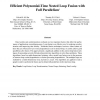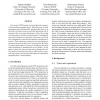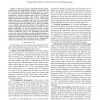70 search results - page 6 / 14 » Autonomic Computing - A Means of Achieving Dependability |
ICPP
1996
IEEE
13 years 11 months ago
1996
IEEE
Data locality and synchronization overhead are two important factors that affect the performance of applications on multiprocessors. Loop fusion is an effective way for reducing s...
Publication
In this paper, we consider a decentralized supply chain formation problem for linear, multi-echelon supply chains when the managers of the individual echelons are autonomous, ratio...
ICDCSW
2006
IEEE
14 years 1 months ago
2006
IEEE
Peer-to-peer (P2P) systems are based upon the cooperative interactions of member peers. Typically, peers are both autonomous and self-interested, meaning that there is no hierarch...
CF
2005
ACM
13 years 9 months ago
2005
ACM
Data-driven array architectures seem to be important alternatives for coarse-grained reconfigurable computing platforms. Their use has provided performance improvements over micro...
IJCNN
2006
IEEE
14 years 1 months ago
2006
IEEE
— In-place learning is a biologically inspired concept, meaning that the computational network is responsible for its own learning. With in-place learning, there is no need for a...



